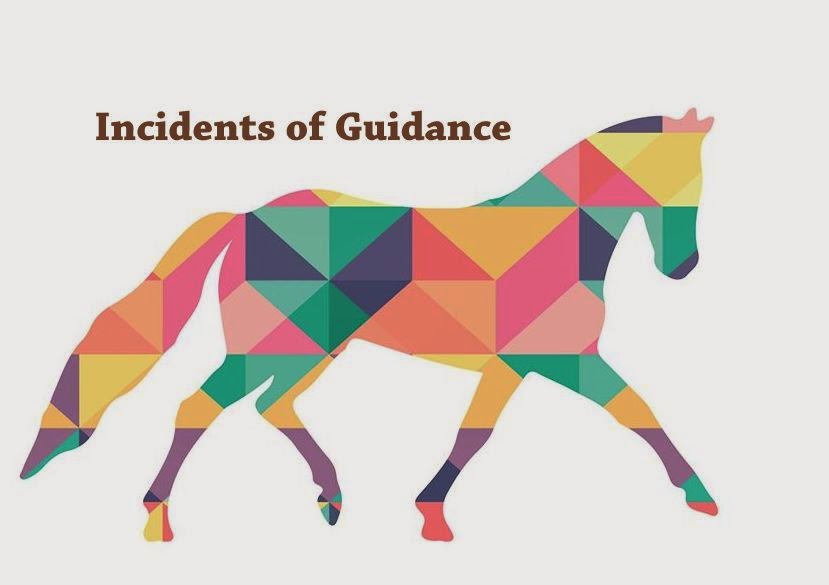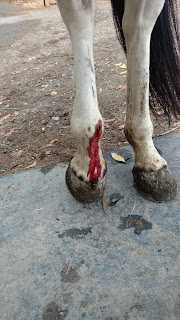I don't really have any media, so here's a (long) video from my last lesson with Tango/Tracey wherein for the first time I feel like I look really good at the canter. Just skip to about a minute or two in and tell yourself, damn, that's a decent thoroughbred hahahah
Here's what I learned in this lesson:
-Keeping your hands behind the bit rings helps you to guide the horse to straightness from your seat
I tend to let my right hand come over the neck when I'm tracking left, and then when I get the right hand where I want it, my left hand sneaks up to the withers. I think I'm asking for more bend, but the correct thing is to shorten the rein so that a small movement to the inside of the circle takes a feel on his mouth.
If the rein is too long and I have to move my hand backwards, I'm going to change the balance and be less able to influence his straightness with my thighs and lower leg. I need to keep my reins shorter without thinking I need to post over them, I can keep my upper body away from my hands.
If the hands are over the middle of the horse, then all I'm doing is encouraging a twisted neck which does NOT allow the energy to come forward over his back and through the deep muscles of his neck.
-If you over-open your inside rein to help show the horse the bend you want, you can't just snap it back to central, be gentle
Tracey had me first ask for bend with my inside leg and a slight matching hold on the inside rein, but if that didn't work I moved the rein toward the center of the circle a few inches (without allowing the outside rein to follow the hand over the withers). Every time he really gave to me, lifted his withers and bent to the circle, I'd snap my hand back to 'home' and he'd sort of fall out off the circle because I wasn't careful in putting myself back to central.
I also need to keep my reins shorter in order to facilitate this more soft movement between over-showing the horse and riding in a more correct place.
-Ask for a bit more than the horse wants to give you, because you're not building muscle unless you're working against resistance
Now this was damn near philosophical. I'm paraphrasing, but essentially she said, "we build strength by working against a bit of resistance. If you're in the gym and the weights are too light, you won't be building muscle. If you're just going along the way you like to go along, it might be nice, but it's never going to change anything."
 |
| This is the Thoroughbred in question, in case you've forgotten in this wall of text |
This is related to a more overall reactivity I apparently have when I'm riding. If you sort of wait until a problem has already happened, it's harder for the horse to understand you don't want them to do it. We did about fifteen thousand walk trot walk trot transitions all in the sitting trot in this lesson, and you have to stay really focused and feeling in order to ask them to do these transitions correctly.
As in: a round, soft, carrying transition doesn't just happen with repetitions willy-nilly, you have to sort of show the horse how you want it done, then do it that way a bajillion times until it becomes either more natural for your mind to explode when you do something you've literally done since your third riding lesson or the horse starts to create the new habit.
-To better sit the trot, carry your bear-down deeper into your pelvis
I consider myself a pretty fit person, I ride a lot, I should theoretically be pretty riding-fit.
HAHAHAHAHAHAHAHAHAHA WHAT A JOKE SERIOUSLY
But in all seriousness, it's very easy to get a bit sloppy when you've got four more horses to ride in a day. You sort of conserve yourself - but then you start to coast, and you need to work against some resistance to improve, and if I am able to reach the end of the day not really feeling terribly physically exhausted, I'm cheating.
So when you cough, or clear your throat, or hiss, or growl (go on, try one of the four. I'll wait.) you engage the deeper supporting muscles of the core, but you'll also do a much better job of toning the muscles closer to your ribcage than to your groin. It's human nature.
You have to extend that engagement deep into your pelvic floor (while remaining relaxed) in order to fully support your body in the sitting trot.
And as Tracey pointed out, the horse has to stay round and bending and forward while you focus on this.
-At any point if you leave an aid on for more than five steps you've forgotten what the aid was for (but you can apply an aid once every step for 5+ steps as long as you know what you're trying to do)
-Keep my head up and my ribs down to better feel the horse and remain in vertical balance
-Tango's forehead needs to draw the circle, so I need to bend him and then soften and then ask for the bend long before he comes off the circle
I mentioned this earlier, wherein I'm a bit reactive in my riding and just need to catch the changes when it feels like the muscles are just beginning to think about coming out of where I want him, not when he's already in motion. I also love to draw 20-meter circles full of fishtails, this is related.
-Keep both seat bones on the saddle and your mid-line over the withers in order to help the withers come to vertical
Let's say the horse is leaning to the left. I just picked a direction, it's probably not the direction my horse leans.
(Dammit the problems with my horses remain my fault: why can't I just blame them for being bad?)
-Slow down a lot to allow him to get more clearly cadenced
Tango has a QUITE forward trot (read, quick) that feels pretty decent. He's responsive, he's maneuverable, he's light in the bridle, he's basically round, but there's a trot hiding in that wonderful thoroughbred body that has some real suspension. Not a lot, not world-beating amazing, but it's there. And to get him to build that trot, I cannot push him past it, tempo-wise.
I have to bring him to a much much slower trot without allowing the energy to dissipate (western crossover event horse?) and ask him to be straight and bending and round in that slower trot. And keep my reins short enough to actually use them.
-When the horse is using their body, the base of their neck fills out
Tracey described it like a fire hose that fills up in the base of their neck, and you have to build the tone and engagement in their hindquarters and gently push it forward through their neck without losing balance/tempo/letting your reins get too long
-There is a difference between a moment of strength and a moment of rigidity
We let Tango have quite a long break between cantering one way and cantering the other way, and when I gathered the reins up (but make them shorter Kate honestly you've mentioned the reins thing six times in one blog post) Tango did not really want to come back to play. It was over 90 degrees and he's already sprouting a coat so he was pretty tired. When he flipped up at me I pretty strongly closed my hands and put my inside leg on - get off my legs and yield to the hands.
But I did it too rigidly - and I need to think of remaining fluid in my motions even if the muscle tone has to get really high for a moment.
















